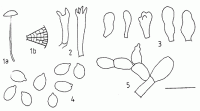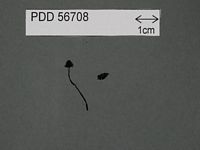|
 Mycena vinaceipora Mycena vinaceipora
BiostatusPresent in region - Indigenous. Endemic
Images (click to enlarge)
Caption: Fig.12 M. vinaceipora. la. basidiome. 1b. arrangement of lamellae, magnified. 2. basidia. 3. cheilocystidia. 4. basidiospores. 5. pileipellis elements. | 
Caption: Dried type specimen
Owner: Herb PDD |
Article: Segedin, B.P. (1991). Studies in the Agaricales of New Zealand: some Mycena species in sections Longisetae, Polyadelpha, Rubromarginatae, Galactopoda, Lactipedes, and Calodontes. New Zealand Journal of Botany 29(1): 43-62 (http://www.rsnz.org/publish/abstracts.php).
Description: Pileus 10 mm diam.,
convex to plane, hygrophanous, reddish-brown (porphyreus) (7E6 K&W) when
moist, drying to vinaceous brown (7D4), smooth, dry. Lamellae in 3 series, 11
reaching the stipe, dark vinaceous (I0D7), slightly decurrent, very shallow,
thick, with a darker edge, with very symmetrical cross-veining almost reaching
the level of the lamellae, giving a distinctly poroid appearance. Stipe 30 X
1-2 mm, yellowish-brown, paler at the top, smooth and shining, even, fistulose,
with yellow flesh. Flesh yellowish, crystalline. Smell and taste not known.
Colour of spore
print not known. Spores 4.5-6 X 2.5-5 (4.8 X 3.3) µm, Q=1.4, ellipsoid, hyaline,
faintly amyloid, thin-walled, with a prominent apiculus. Basidia 16-29 X 10-12
µm, 2- or 4-spored, with long, stout sterigmata, some basidia containing red
globules. Cheilocystidia 15-25 X 4-10 µm, crowded in a thick layer, very varied
in shape from clavate to utriform, either simple, or with l or 2 blunt protrusions
or slight diverticulation, with red-brown sap and red globules in some of the
cheilocystidia. Pleurocystidia none. Pileipellis a layer of repent hyphae, branched,
5-15 µm diam., containing many red-brown globules; subpellis of roughly spherical
cells 15-30 µm. diam., containing yellow sap. Trama vinescent in Melzer's. Context
of interwoven, narrower hyphae, with some conducting hyphae and clusters of
more or less spherical cells filled with fine, yellow, granular cytoplasm. Caulocystidia
none.
Habitat: HABITAT: Solitary on the ground in mixed podocarp-dicotyledonous
forest.
Notes: ETYMOLOGY: The specific epithet refers to the colour
and poroid appearance of the hymenophore.
Overall red-vinaceous
colouring, strongly interveined lamellae, amyloid spores, simple cheilocystidia
and little differentiated pileipellis place this fungus in Mycena sect.
Calodontes (Fr.: Berk.) Quel. The darker edge to the lamellae places it in subsection
Marginatae J. E. Lange. The conspicuous interveining and absence of pleurocystidia
suggest a closer relationship with M. violacella (Speg.) Sing., subsection
Violacellae, but this subsection is characterised by having inamyloid spores
(Maas Geesteranus 1989). M. tesselata (Mont.) Dennis, which Pegler (1983)
groups with M. pearsoniana Dennis ex Sing. and M. violacella as
having interveined lamellae and lacking pleurocystidia, also has weakly amyloid
spores like M. vinaceipora. The basis of Maas Geesteranus 1989 subdivision
of the section Calodontes may need revision when further extra limital species
are described. Another representative of the section Calodontes commonly found
in New Zealand is M. fuscovinacea Stevenson which with its strong resemblance
to M. pura (Pers.: Fr.) Kummer, would belong in subsection Purae.
|